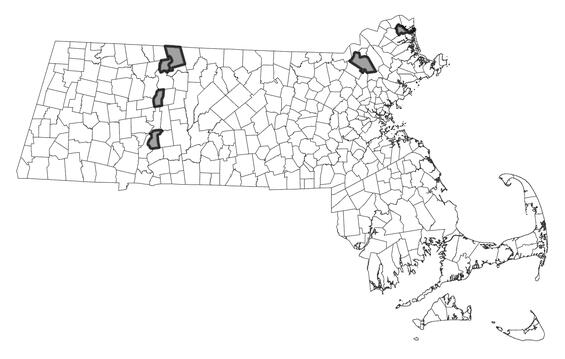- Scientific name: Elatine americana
- Species of Greatest Conservation Need (MA State Wildlife Action Plan)
- Endangered (MA Endangered Species Act)
Description
American waterwort (Elatine americana) is a minute, broad-leaved, annual species of freshwater mudflats. Plants are tufted with creeping or submersed stems (0.5-2.5 cm [0.2-1 in] long) and small (3-8 mm [0.12-0.31 in] long, 1–4 mm [0.04-0.16 in] wide) opposite leaves. Leaf blades are mostly obovate in shape, rounded at tip, toothless, and sessile. Flowers are minute (≤4 mm [0.16 in] long), three-parted, and produced singly in the leaf axils. Fruits are three-lobed capsules and membranous (thin-walled), revealing the enclosed seeds.
American waterwort is a small, delicate plant that can be easily overlooked. Stems usually grow prostrate and form dense mats (up to 200 cm [6.5 ft] wide). Waterwort species (family Elatinaceae) are very similar and most easily identified when in fruit, especially since levels of exposure (emergent versus submerged) can greatly influence their general appearance. Mature seeds (under magnification) are critical to correctly identify the species. Seeds are cylindrical in shape with pitted seed coats. American waterwort seeds have rows of elongated, angular (six-sided) pits, with the pits becoming smaller towards ends of the seed.
Lesser waterwort (Elatine minima) is a more common, mat-forming species occurring on muddy pond shores and sometimes intertidal mudflats. It is distinguished from American waterwort by its smaller (<5 mm [0.2 in] long, <3mm [0.12 in] wide), more linear to spatulate leaves, two-lobed fruits, and seeds with rounded pits that are uniform in size. American waterwort also resembles water starworts (Callitriche spp.). Water starworts differ by longer (usually > 5 cm [2 in]) stems, unisexual flowers (lacking perianth), two-lobed fruits, and more widely-spaced pairs of leaves. Foliage of water starworts is often dimorphic too, with a rosette of floating, spatulate leaves accompanying the submersed, linear leaves.
Life cycle and behavior
Fruits mature in late summer.
Population status
American waterwort is listed under the Massachusetts Endangered Species Act as Endangered. All listed species are protected from killing, collecting, possessing, or sale and from activities that would destroy habitat and thus directly or indirectly cause mortality or disrupt critical behaviors. The MassaWildlife’s Natural Heritage & Endangered Species Program database has 10 records from 6 counties: Essex, Franklin, Hampden, Hampshire, Middlesex, and Plymouth. Six of these records have been observed within the last 25 years.

Distribution in Massachusetts
1999-2024
Based on records in the Natural Heritage Database
Distribution and abundance
American waterwort occurs from eastern Quebec and Nova Scotia, south through most of the Atlantic and Gulf States to Louisiana, and then scattered into western states.
Habitat
American waterwort occurs on open muddy shores of ponds or tidal rivers and tributaries. Plants found in association with American waterwort include common arrowhead (Sagittaria latifolia), grass-leaf arrowhead (Sagittaria graminea), red-footed spike-sedge (Eleocharis erythropoda), and water smartweed (Persicaria amphibia).
Healthy habitats are vital for supporting native wildlife and plants. Explore habitats and learn about conservation and restoration in Massachusetts.
Threats
Because this plant occurs on open pond margins and tidally influenced stream banks, presumably any alteration in the hydrologic regime or erosion and sedimentation rates could impact the species. Competition from invasive wetland species could also reduce the available habitat of American waterwort.
Conservation
As for many rare species, exact needs for management of American waterwort are not known. All active management of rare plant populations (including invasive species removal) is subject to review under the Massachusetts Endangered Species Act and should be planned in close consultation with MassWildlife’s Natural Heritage & Endangered Species Program.
References
Crow, G.E., and C.B. Hellquist. 2000. Aquatic and Wetland Plants of North America. Vol. 1. University of Wisconsin Press, Madison.
Contact
| Date published: | April 14, 2025 |
|---|